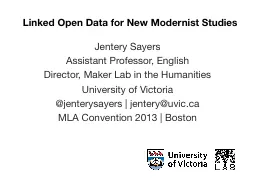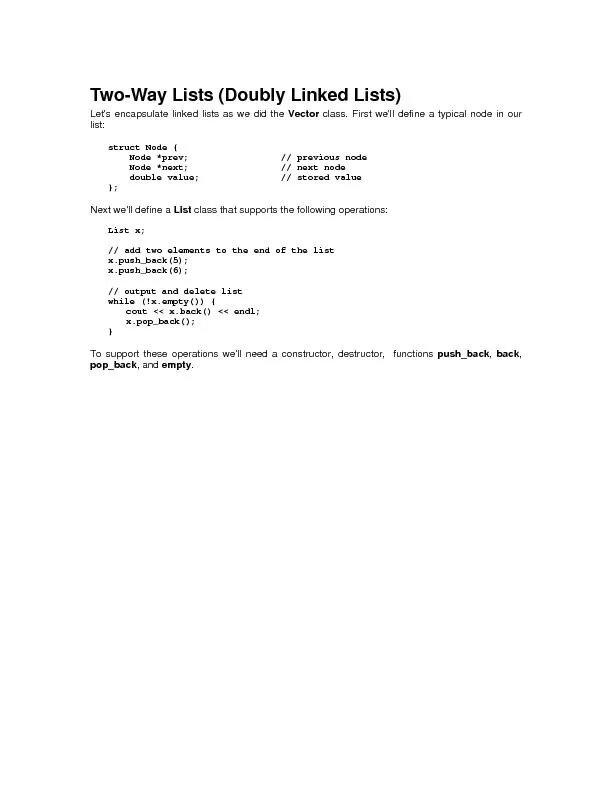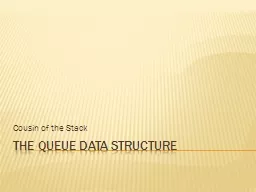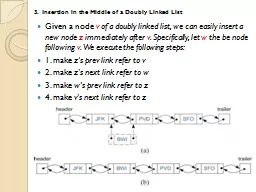PDF-Copyright Ananda Gunawardena Lecture Doubly Linked
Author : mitsue-stanley | Published Date : 2015-06-04
Unlike singly linked lists where traversal is only one way doubl y linked lists allow traversals in both ways A generic doubly linked list node can be desi gned
Presentation Embed Code
Download Presentation
Download Presentation The PPT/PDF document "Copyright Ananda Gunawardena Lecture ..." is the property of its rightful owner. Permission is granted to download and print the materials on this website for personal, non-commercial use only, and to display it on your personal computer provided you do not modify the materials and that you retain all copyright notices contained in the materials. By downloading content from our website, you accept the terms of this agreement.
Copyright Ananda Gunawardena Lecture Doubly Linked: Transcript
Unlike singly linked lists where traversal is only one way doubl y linked lists allow traversals in both ways A generic doubly linked list node can be desi gned as typedef struct node void data struct node next struct node prev node node head nod. Singly linked lists are flexible structures where memory can be allocated in small blocks as needed Also when deleting or inserting nodes from a singly linked list the overhead is re latively low compared to array insertions where array elements ha Jentery Sayers. Assistant Professor, English. Director, Maker Lab in the Humanities. University of Victoria. @jenterysayers. | jentery@. uvic.ca. MLA Convention 2013 | Boston . Today, with “Avenues of Access” in mind: . Essential Question: . How are dominant and recessive sex-linked traits passed onto offspring?. Sex-linked traits are determined by genes on sex-chromosomes.. Most. sex-linked alleles (genes) are carried on the X chromosome. . Incubator Group. Preliminary . results. 2 June 2011. W3C Library Linked Data Incubator Group. Chartered May 2010 thru August 2011. Members here at LOD-LAM:. Antoine Isaac (co-chair), Tom Baker (co-chair), Jodi Schneider, Hideaki Takeda, . class List { List() { head = new Node; ��head-next = head-prev = head; } // destructor virtual ~List() { �Node *p = head-next; while (p != head) { Node *next = �p-next; delete p; 1. Singly Linked Lists. Presentation for use with the textbook . Data Structures and Algorithms in Java, 6. th. edition. , by M. T. Goodrich, R. Tamassia, and M. H. Goldwasser, Wiley, . 2014. Singly Linked Lists. Chapter 3. 1. 2. Data Abstraction. separates the logical properties of . a data . type from its . implementation. LOGICAL PROPERTIES. What. are the possible values? . What. operations will be needed?. Cousin of the Stack. Examples of Queues. Queue. An abstract data type (container class) in which items are entered at one end and removed from the other end. First In First Out (FIFO). No standard queue terminology. Humans have approximately . 20,000 – 30,000. genes that code for traits. . However, only have . 46 chromosomes. . Thus each chromosome must have . many genes. on them. . Often seen in . Sex-Linked Traits. Data Structure. Marcus Biel, Software . Craftsman. http://www.marcus-biel.com. Terminology. First of all, let’s have a look at the term “Linked List”. . Why . is Linked List actually called Linked List?. Topics to be discussed…. Linked list. More terminology. Singly-linked lists. Doubly-linked lists. DLLs compared to SLLs. Circular Lists. Linked list. a. b. c. d. Each node contains a . value. and a . Hongfei. Yan. Apr. 6, 2016. live.gnome.org/. Dia. draw entity relationship diagrams, . Unified Modeling Language . diagrams, flowcharts, network diagrams, and many other diagrams.. The UML models not only application structure, behavior, and architecture, but also business process and data structure.. z. immediately after . v. . Specifically, let . w. the be node following . v. . We execute the following steps: . 1. make . z's. . prev. link refer to v . 2. make . z's. next link refer to w . 3. make . Ralph LeVan. Sr. Research Scientist. OCLC Research. What is Linked Data?. Simple answer:. “The term Linked Data is used to describe a . method. of exposing, sharing, and connecting data via dereferenceable URIs on the Web.” – Wikipedia...
Download Document
Here is the link to download the presentation.
"Copyright Ananda Gunawardena Lecture Doubly Linked"The content belongs to its owner. You may download and print it for personal use, without modification, and keep all copyright notices. By downloading, you agree to these terms.
Related Documents














